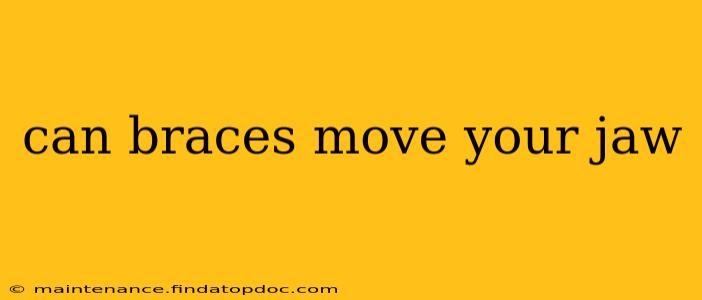Braces are primarily designed to straighten teeth, but their impact extends beyond just cosmetic improvements. Many people wonder, "Can braces move my jaw?" The answer is nuanced and depends on several factors, including your age, the type of orthodontic treatment, and the specific jaw misalignment. Let's explore this topic in depth.
What Types of Jaw Problems Can Braces Address?
While braces aren't solely designed for jaw movement, they can effectively address certain jaw misalignments, particularly in growing children and adolescents. Orthodontists often use braces in conjunction with other treatments to correct jaw discrepancies. Conditions that might benefit from orthodontic treatment involving jaw realignment include:
- Overbite: Where the upper teeth significantly overlap the lower teeth.
- Underbite: Where the lower teeth protrude beyond the upper teeth.
- Crossbite: Where some upper teeth bite inside the lower teeth.
- Open bite: Where there's a gap between the upper and lower teeth when biting down.
- Crowding: Where teeth are too close together, sometimes leading to jaw misalignment.
It's crucial to understand that the extent to which braces can move your jaw is limited. Severe jaw misalignments often require more extensive interventions, such as orthognathic surgery.
Can Braces Move Your Jaw If You're an Adult?
The effectiveness of braces in moving the jaw is significantly reduced in adults. Adult bone is denser and less malleable than that of children and adolescents. While braces can still adjust tooth position in adults, significant jaw repositioning is less likely. Adult orthodontic treatment primarily focuses on tooth alignment and correction of bite problems.
What Other Treatments Might Be Necessary to Move the Jaw?
For significant jaw misalignments, especially in adults, orthodontists often recommend additional treatments, including:
- Orthognathic Surgery: This surgical procedure involves repositioning the jaw bones to correct severe discrepancies. It's usually performed in conjunction with orthodontic treatment (braces) before and after surgery.
- Jaw Expanders: These devices are often used in children and adolescents to widen the upper jaw. They can be employed alongside braces to address certain crossbite issues and create more space for teeth.
- Functional Appliances: These appliances are used to guide jaw growth and development, often in growing individuals. They can be used in conjunction with or as an alternative to braces.
How Long Does it Take for Braces to Move the Jaw?
The timeframe for jaw repositioning with braces varies significantly depending on the individual's age, the severity of the misalignment, and the specific treatment plan. In children and adolescents, it can take months or even years to achieve the desired result. In adults, jaw repositioning with braces is generally less effective and less likely to occur.
Does Jaw Movement with Braces Hurt?
Like any orthodontic treatment, there might be some discomfort associated with jaw repositioning. This discomfort typically manifests as mild to moderate pain or pressure, especially in the initial stages of treatment. Your orthodontist can provide pain relief medication and strategies to manage discomfort.
What are the Risks Associated with Jaw Movement Using Braces?
While generally safe, jaw repositioning with braces carries some potential risks. These include root resorption (loss of tooth root structure), gum recession, and temporary discomfort. It's essential to choose a qualified orthodontist to minimize these risks. A thorough consultation and examination will help determine if braces are the right treatment option for you.
Conclusion
While braces can influence jaw position, especially in growing individuals, they are not a guaranteed solution for significant jaw misalignments. The effectiveness of braces in moving your jaw hinges on various factors, including your age and the severity of the issue. A qualified orthodontist will assess your specific needs and recommend the most appropriate treatment plan, which may or may not involve braces in conjunction with other procedures like surgery or expanders. Always consult a professional for accurate diagnosis and personalized treatment recommendations.
